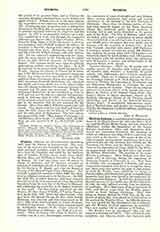

Wichita, Diocese of (WICHITENSIS), erected in 1887, from the Diocese of Leavenworth. The territory of the new see was bounded on the east by the sixth principal meridian, south by the Indian Territory, west by Colorado, and north by the northern lines of Greeley, Wichita, Scott, Lane, Ness, Rush, Barton, Rice, and McPherson Counties in the State of Kansas. At that time there were 16 priests in charge of churches, and 23 churches attended as missions; 9 parochial schools, 2 of which were taught by the Sisters of St. Joseph, and 1 by the Sisters of Charity of the Blessed Virgin Mary (Dubuque). The Catholic population numbered about 8000, but there were no religious communities in the diocese. In 1897 the Holy See attached fourteen additional counties located east of the sixth principal meridian, the eastern boundary being the west line of the State of Missouri, and continuing the north line of the Indian Territory on the south. The first bishop appointed for this Diocese, Rt. Rev. James O’Reilly, of Topeka, Kansas, died on July 26, 1887, before his consecration. One year later, the present bishop, Rt. Rev. John Joseph Hennessy, was selected, and was consecrated on November 30, 1888, in St. John’s Church, St. Louis, Missouri, of which he was rector. The ceremony was performed by Archbishop Kenrick of St. Louis, assisted by Bishops Hennessy of Dubuque, and Fink of Leaven-worth. When the bishop took charge of Wichita, his territory was in a very discouraging condition owing to a succession of years of drought and crop failures. Many settlers abandoned their farms and availed themselves of the opening of the new Territory of Oklahoma. Since then, the Kansas portion of what had been formerly known as the Great American Desert has improved under better methods of farming, and is now justly described as the garden spot of the West. The City of Wichita, called after an Indian tribe, had a population of about 20,000 when established as an episcopal see; it now numbers over 60,000 and is the largest and most thrifty city in Kansas, with the exception of Kansas City. It has four Catholic churches with about 3700 Catholics, 3 parochial schools attended by nearly 400 children, one academy for young ladies with 175 boarders, one industrial school for small children with 120 boarders, one hospital with 125 patients daily, one orphanage with 30 inmates, 1 convent and motherhouse of the diocesan Sisters of St. Joseph.
Diocesan Statistics.—There are 76 secular and 12 regular priests, 69 churches with resident pastors, 58 missions with churches, 7 hospitals, 35 parish schools, with 2400 pupils, and a Catholic population of 32,000. There are 4 religious institutes of men: the Passionist Fathers at St. Paul, Kansas, the Franciscans at Wichita, the Capuchins at Marienthal, and the Silvestrine Benedictines at Chicopee for work especially among the Italians. There are six religious institutes of women: Sisters of St. Joseph (diocesan), Sisters of Charity of the Blessed Virgin Mary (Dubuque); Sisters of Mercy (diocesan), Sisters of St. Dominic (diocesan); Sisters of the Precious Blood (Belleville), and Sisters of the Sorrowful Mother (Rome, Italy). A magnificent Romanesque cathedral of Bedford stone and granite was consecrated in 1912 by His Eminence Cardinal Gibbons, Archbishop of Baltimore.
JOHN J. HENNESSY

